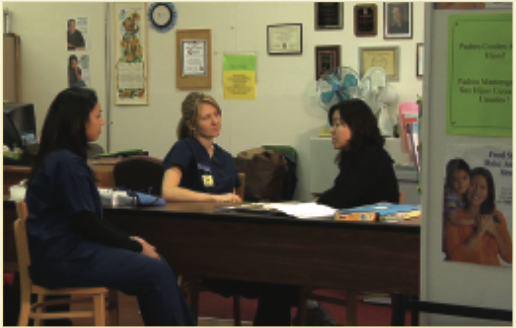Research supports need for project
“The STI rate has been declining in Chicago, but increasing by two to three times in this community,” says Dr. Young-Me Lee, an
assistant professor in the Department of Nursing who is leading the
nursing department’s work in this project. “Many people don’t
have health insurance, or face language barriers, or don’t have
information about STI.” Research by Dr. Lee and her team showed
that there was “high incidence of STI’s in the Back of the Yards
community, especially for women as a result of a knowledge deficit
of safer sex practices, symptoms recognition and ability to inform
partners.” More than one of three people in the community are
living below the poverty line, research showed, and STI rates are
considerably higher in the community than in the general
population. The following year, Dr. Lee asked a group of nursing students to
design an intervention program that focused in part on these issues.
Building a partnership
Although some may point out ways that STI workshops could be
controversial, nursing students – and all partners in this project –
were focused on the same goals. The focus was on preventing STIs by
identifying the problem early, educating people and getting them
treated. To make that happen, partners in this project agree, a wide range of people and organizations focused on community health worked
together. “No one organization owns this screening,” says Mike
Anderer-McClelland, Principal & Campus Director, San Miguel School,
Back of the Yards. “Everybody feels like it’s theirs. The Steans Center
has not just been working with one organization, but has been able to work with several organizations. Steans has
managed to get to know all of us.” “For this project, credit is not as important as providing services to an underserved community,” adds Paco Zamora, Technical Assistance and Capacity Development Coordinator for Howard Brown
Community Services.
Reaching the community
At Second Chance School, students who walk into the STI screening
room go through three stations – intake, counseling and, finally,
screening. Elizabeth Florez, a graduate of the nursing program who
still volunteers at STI screenings, was involved in creating surveys and
assessment worksheets that have been part of this effort. “As a
nurse, you are always going to be educating people, and this project
definitely brings you closer to the community. Once I leave the site of
the screening, I feel so happy that I was able to help other people. If
I just went to a job, or to school, I don’t know if it would be as
fulfilling.”
Meanwhile, Sharon Dopak, who is completing her nursing degree
this spring, says that participating in this project has fulfilled her
hope to gain more experience in a community-based setting. “I really
enjoy helping people when they are in situations where they don’t
have resources or information about where to go,” she says. “I’ve
also learned through this project that organization – and constant
follow-up – are key when making partnerships work.”
Potential of program
The Department of Nursing’s experience in the Back of the Yards community is also serving as a model for its work in other
underserved communities, says Dr. Poslusny. In the North Lawndale
community, the Department of Nursing has been collaborating with
four schools to provide a range of health-related services, including
physicals and health education. “Our long-term goal here, as in Back
of the Yards, is to develop a partnership so that we can maintain a
continuing presence in communities and provide service learning
opportunities for students,” she says. “That will include individual
and group reflection.” The model is also being shared with other
schools at DePaul, suggesting that it can work for those offering
education, social work and other services.
“Our long-term goal here, as in Back of the
Yards, is to develop a partnership so that
we can maintain a continuing presence in
communities and provide service learning
opportunities for students.”
Meanwhile, partners in the STI program also say it could be
replicated elsewhere in Chicago – and perhaps around the country.
Maria Mendez, parish nurse for Holy Cross Hospital, has provided
screening services at the STI screenings. “I think this is a very valuable
program that would benefit many other communities,” adds
Mendez. “In the Back of the Yards community, many parents and
older people don’t have information about these issues – so how are
they going to be able to talk to children about them?”

Though STIs have been controlled in many communities, there are
still 19 million new cases every year, according to the Centers for
Disease Control. About half of those cases involve young adults
between the ages of 15 and 24. The prevalence of the problem, and
promise of the partnership in the Back of the Yards community,
suggests that this kind of partnership could make an impact in other
communities that need similar services. “This experience has really
taught us the importance of community partnerships,” says Dr. Lee.
“We believe this effort could be a model for future projects.”